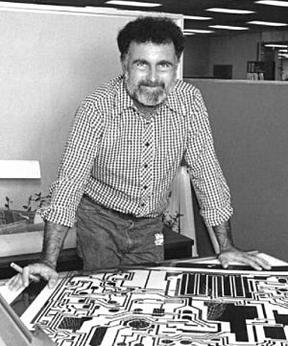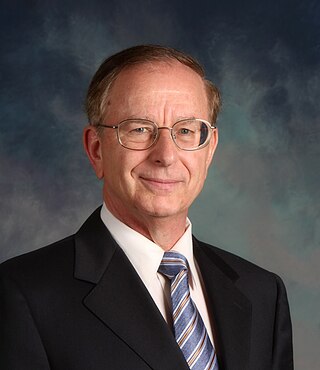
Robert Norton Noyce, nicknamed "the Mayor of Silicon Valley", was an American physicist and entrepreneur who co-founded Fairchild Semiconductor in 1957 and Intel Corporation in 1968. He was also credited with the realization of the first monolithic integrated circuit or microchip, which fueled the personal computer revolution and gave Silicon Valley its name.

Silicon Valley is a region in Northern California that serves as a global center for high technology and innovation. Located in the southern part of the San Francisco Bay Area, it corresponds roughly to the geographical area of the Santa Clara Valley. San Jose is Silicon Valley's largest city, the third-largest in California, and the tenth-largest in the United States; other major Silicon Valley cities include Sunnyvale, Santa Clara, Redwood City, Mountain View, Palo Alto, Menlo Park, and Cupertino. The San Jose Metropolitan Area has the third-highest GDP per capita in the world, according to the Brookings Institution, and, as of June 2021, has the highest percentage of homes valued at $1 million or more in the United States.

The Homebrew Computer Club was an early computer hobbyist group in Menlo Park, California, which met from March 1975 to December 1986. The club had an influential role in the development of the microcomputer revolution and the rise of that aspect of the Silicon Valley information technology industrial complex.

Fairchild Semiconductor International, Inc. was an American semiconductor company based in San Jose, California. Founded in 1957 as a division of Fairchild Camera and Instrument, it became a pioneer in the manufacturing of transistors and of integrated circuits. Schlumberger bought the firm in 1979 and sold it to National Semiconductor in 1987; Fairchild was spun off as an independent company again in 1997. In September 2016, Fairchild was acquired by ON Semiconductor.

Gordon Earle Moore was an American businessman, engineer, and the co-founder and emeritus chairman of Intel Corporation. He proposed Moore's law which makes the observation that the number of transistors in an integrated circuit (IC) doubles about every two years.

The history of computing hardware starting at 1960 is marked by the conversion from vacuum tube to solid-state devices such as transistors and then integrated circuit (IC) chips. Around 1953 to 1959, discrete transistors started being considered sufficiently reliable and economical that they made further vacuum tube computers uncompetitive. Metal–oxide–semiconductor (MOS) large-scale integration (LSI) technology subsequently led to the development of semiconductor memory in the mid-to-late 1960s and then the microprocessor in the early 1970s. This led to primary computer memory moving away from magnetic-core memory devices to solid-state static and dynamic semiconductor memory, which greatly reduced the cost, size, and power consumption of computers. These advances led to the miniaturized personal computer (PC) in the 1970s, starting with home computers and desktop computers, followed by laptops and then mobile computers over the next several decades.

Federico Faggin is an Italian physicist, engineer, inventor and entrepreneur. He is best known for designing the first commercial microprocessor, the Intel 4004. He led the 4004 (MCS-4) project and the design group during the first five years of Intel's microprocessor effort. Faggin also created, while working at Fairchild Semiconductor in 1968, the self-aligned MOS (metal-oxide-semiconductor) silicon-gate technology (SGT), which made possible MOS semiconductor memory chips, CCD image sensors, and the microprocessor. After the 4004, he led development of the Intel 8008 and 8080, using his SGT methodology for random logic chip design, which was essential to the creation of early Intel microprocessors. He was co-founder and CEO of Zilog, the first company solely dedicated to microprocessors, and led the development of the Zilog Z80 and Z8 processors. He was later the co-founder and CEO of Cygnet Technologies, and then Synaptics.

The traitorous eight was a group of eight employees who left Shockley Semiconductor Laboratory in 1957 to found Fairchild Semiconductor. William Shockley had in 1956 recruited a group of young Ph.D. graduates with the goal to develop and produce new semiconductor devices. While Shockley had received a Nobel Prize in Physics and was an experienced researcher and teacher, his management of the group was authoritarian and unpopular. This was accentuated by Shockley's research focus not proving fruitful. After the demand for Shockley to be replaced was rebuffed, the eight left to form their own company.
Jay Taylor Last was an American physicist, silicon pioneer, and member of the so-called "traitorous eight" that founded Silicon Valley.
Walter Jeremiah Sanders III is an American businessman and engineer who was a co-founder and long-time CEO of the American semiconductor manufacturer Advanced Micro Devices (AMD). From 1969 to 2002, Sanders served as AMD's CEO.
Signetics Corporation was an American electronics manufacturer specifically established to make integrated circuits. Founded in 1961, they went on to develop a number of early microprocessors and support chips, as well as the widely used 555 timer chip. The company was bought by Philips in 1975 and incorporated in Philips Semiconductors.
Electronic News was a publication that covered the electronics industry, from semiconductor equipment and materials to military/aerospace electronics to supercomputers. It was originally a weekly trade newspaper, which covered all aspects of the electronics industry, including semiconductors, computers, software, communications, space and even television electronics.

Robert John Widlar was an American electronics engineer and a designer of linear integrated circuits (ICs).

Michael Shawn Malone is an American author, columnist, editor, investor, businessman, television producer, and has been the host of several shows on PBS. Currently (2009), Malone is a columnist for ABC News, an op-ed contributor for The Wall Street Journal, a contributing editor to Wired, and the editor-in-chief of Edgelings.com, a website focused on business and technology news in Silicon Valley.
Cromemco was a Mountain View, California microcomputer company known for its high-end Z80-based S-100 bus computers and peripherals in the early days of the personal computer revolution.

Gerald Anderson Lawson was an American electronic engineer. He is known for his work in designing the Fairchild Channel F video game console as well as leading the team that pioneered the commercial video game cartridge. He was thus dubbed the "father of the videogame cartridge" according to Black Enterprise magazine in 1982. He eventually left Fairchild and founded the game company Video-Soft.

Harry T. Garland is a scientist, engineer, author, and entrepreneur who co-founded Cromemco Inc., one of the earliest and most successful microcomputer companies. He received the B.A. degree in mathematics from Kalamazoo College, and the Ph.D. degree in biophysics from Stanford University. Dr. Garland has been recognized as one of the most important innovators in the development of personal computers in Silicon Valley.

Mohamed M. Atalla was an Egyptian-American engineer, physicist, cryptographer, inventor and entrepreneur. He was a semiconductor pioneer who made important contributions to modern electronics. He is best known for inventing the MOSFET in 1959, which along with Atalla's earlier surface passivation and thermal oxidation processes, revolutionized the electronics industry. He is also known as the founder of the data security company Atalla Corporation, founded in 1972. He received the Stuart Ballantine Medal and was inducted into the National Inventors Hall of Fame for his important contributions to semiconductor technology as well as data security.

The Inventor: Out for Blood in Silicon Valley is a 2019 American documentary film, directed and produced by Alex Gibney. The film revolves around Elizabeth Holmes and her former company Theranos. It is considered a companion piece to the book, Bad Blood: Secrets and Lies in a Silicon Valley Startup.











